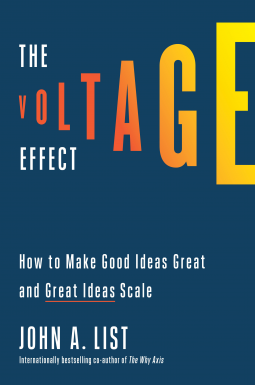
The Voltage Effect
How to Make Good Ideas Great and Great Ideas Scale
by John A. List
This title was previously available on NetGalley and is now archived.
Buy on Amazon
Buy on BN.com
Buy on Bookshop.org
*This page contains affiliate links, so we may earn a small commission when you make a purchase through links on our site at no additional cost to you.
Send NetGalley books directly to your Kindle or Kindle app
1
To read on a Kindle or Kindle app, please add kindle@netgalley.com as an approved email address to receive files in your Amazon account. Click here for step-by-step instructions.
2
Also find your Kindle email address within your Amazon account, and enter it here.
Pub Date Feb 01 2022 | Archive Date Jan 31 2022
Crown Publishing | Crown Currency
Talking about this book? Use #TheVoltageEffect #NetGalley. More hashtag tips!
Description
NATIONAL BESTSELLER • A leading economist answers one of today’s trickiest questions: Why do some great ideas make it big while others fail to take off?
“Brilliant, practical, and grounded in the very latest research, this is by far the best book I’ve ever read on the how and why of scaling.”—Angela Duckworth, CEO of Character Lab and New York Times bestselling author of Grit
LONGLISTED FOR THE PORCHLIGHT BUSINESS BOOK AWARD
“Scale” has become a favored buzzword in the startup world. But scale isn't just about accumulating more users or capturing more market share. It's about whether an idea that takes hold in a small group can do the same in a much larger one—whether you’re growing a small business, rolling out a diversity and inclusion program, or delivering billions of doses of a vaccine.
Translating an idea into widespread impact, says University of Chicago economist John A. List, depends on one thing only: whether it can achieve “high voltage”—the ability to be replicated at scale.
In The Voltage Effect, List explains that scalable ideas share a common set of attributes, while any number of attributes can doom an unscalable idea. Drawing on his original research, as well as fascinating examples from the realms of business, policymaking, education, and public health, he identifies five measurable vital signs that a scalable idea must possess, and offers proven strategies for avoiding voltage drops and engineering voltage gains. You’ll learn:
• How celebrity chef Jamie Oliver expanded his restaurant empire by focusing on scalable “ingredients” (until it collapsed because talent doesn’t scale)
• Why the failure to detect false positives early on caused the Reagan-era drug-prevention program to backfire at scale
• How governments could deliver more services to more citizens if they focused on the last dollar spent
• How one education center leveraged positive spillovers to narrow the achievement gap across the entire community
• Why the right set of incentives, applied at scale, can boost voter turnout, increase clean energy use, encourage patients to consistently take their prescribed medication, and more.
By understanding the science of scaling, we can drive change in our schools, workplaces, communities, and society at large. Because a better world can only be built at scale.
“Brilliant, practical, and grounded in the very latest research, this is by far the best book I’ve ever read on the how and why of scaling.”—Angela Duckworth, CEO of Character Lab and New York Times bestselling author of Grit
LONGLISTED FOR THE PORCHLIGHT BUSINESS BOOK AWARD
“Scale” has become a favored buzzword in the startup world. But scale isn't just about accumulating more users or capturing more market share. It's about whether an idea that takes hold in a small group can do the same in a much larger one—whether you’re growing a small business, rolling out a diversity and inclusion program, or delivering billions of doses of a vaccine.
Translating an idea into widespread impact, says University of Chicago economist John A. List, depends on one thing only: whether it can achieve “high voltage”—the ability to be replicated at scale.
In The Voltage Effect, List explains that scalable ideas share a common set of attributes, while any number of attributes can doom an unscalable idea. Drawing on his original research, as well as fascinating examples from the realms of business, policymaking, education, and public health, he identifies five measurable vital signs that a scalable idea must possess, and offers proven strategies for avoiding voltage drops and engineering voltage gains. You’ll learn:
• How celebrity chef Jamie Oliver expanded his restaurant empire by focusing on scalable “ingredients” (until it collapsed because talent doesn’t scale)
• Why the failure to detect false positives early on caused the Reagan-era drug-prevention program to backfire at scale
• How governments could deliver more services to more citizens if they focused on the last dollar spent
• How one education center leveraged positive spillovers to narrow the achievement gap across the entire community
• Why the right set of incentives, applied at scale, can boost voter turnout, increase clean energy use, encourage patients to consistently take their prescribed medication, and more.
By understanding the science of scaling, we can drive change in our schools, workplaces, communities, and society at large. Because a better world can only be built at scale.
Available Editions
| EDITION | Other Format |
| ISBN | 9780593239483 |
| PRICE | $28.00 (USD) |
| PAGES | 288 |



